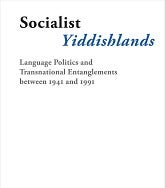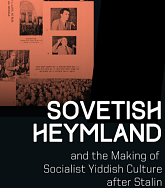
April 1, 2025 - 9:00am
The perpetrators of World War II left mass destruction in their wake across much of Europe, physically and culturally. Research has, for the most part, ignored the cultural activities, the political engagement and the work of cultural activists who remained in Eastern Europe after the war. A new book, co-edited by Miriam Chorley-Schulz, assistant professor and Mokin Fellow of Holocaust Studies, examines these issues specifically related to Yiddish language and culture.
“By challenging Cold War stereotypes, Socialist Yiddishlands charts the complex landscape of the archipelago of Yiddish culture as it reemerged beyond the 'Iron Curtain' after the devastations of the Holocaust. Rather than portraying the interaction between Yiddish culture and communist regimes as a zero-sum game, the contributors explore how Yiddish activists attempted to integrate their visions of diasporic Jewish modernity into realities shaped by those political systems,” said Mikhail Krutikov, professor of Slavic and Judaic Studies at the University of Michigan, Ann Arbor, in a review of the book.
For most survivors of World War II, the old homeland in the East was a lost place and a place of transit to the centers of the reconfiguring “West,” which included North America, the global South and the young state of Israel. But the Yiddish communities in Eastern Europe were shattered and largely decimated.

In the book, Socialist Yiddishlands: Language Politics and Transnational Entanglements between 1941 and 1991, case studies on Poland, the Soviet Union, the German Democratic Republic and Romania uncover diverse cultural reconstruction initiatives and cross-bloc entanglements with western countries, such as Great Britain, the United States, Argentina and Israel.
Readers will learn how the key players positioned themselves within socialist narratives of the past, present and future, and vis-à-vis the Jewish diasporas. Authors explain visions for Yiddishlands in the new world of state-socialism and how they attempted to implement them.
“Socialist Yiddishlands utilizes cutting-edge theories and methods to offer a post-Cold War reexamination of Yiddish cultural production in Eastern bloc countries that moves beyond binaries and ideological interpretations to engage seriously with what was created, the circumstances of its creation, and the ongoing transnational ties amongst Yiddishists throughout the period. This innovative collection of essays will cause many scholars to rethink their assumptions and return to an overlooked oeuvre,” said Eliyana Adler of Binghamton University in a review of the book.
Chorley-Schulz's co-editor is Dr. Alexander Walther, research assistant at the State Museum of Archaeology Chemnitz.
“In editing Socialist Yiddishlands, it was important to Alexander and me to tell a much more complicated story about Yiddish in the Cold War – and to do so from the vantage point of the Second World. Bringing together experts from around the world, working on this book has certainly reshaped my way of thinking about Jewish diasporas, their entanglements and competitions, in a radically altered world after 1945, and I hope that I will not be alone in this,” said Chorley-Schulz.

In addition to co-editing the book exploring stories of Yiddish culture, Chorley-Schulz recently acquired, with the team at Knight Library, a complete and pristine set of the Soviet Yiddish journal, “Sovetish Heymland,” which translates to Soviet homeland. It is the only Soviet Yiddish journal of the post-Stalinist period published from 1961 to 1991. Chorley-Schulz curated an exhibition about the journal that is currently showing at the Knight Library.
